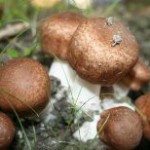 Mushrooms are unique. Unlike other plants, they do not convert the sun’s rays into energy. Mushrooms belong to the macrofungi, because their fruiting structures are large enough to be seen with the naked eye. They get nutrition from animal and plant matter. Many species are quite specific about their food source and will be found only under or near certain kinds of trees-some under pines, others under oak, etc. Mushrooms secrete digestive enzymes into the environment and then absorb the products of digestion for their nourishment. This decomposition process benefits the ecosystem. It decomposes dead plant and animal matter that, without the mushrooms, would accumulate to unmanageable levels, and it returns nitrogen, phosphorus, and other nutrients to the …
Mushrooms are unique. Unlike other plants, they do not convert the sun’s rays into energy. Mushrooms belong to the macrofungi, because their fruiting structures are large enough to be seen with the naked eye. They get nutrition from animal and plant matter. Many species are quite specific about their food source and will be found only under or near certain kinds of trees-some under pines, others under oak, etc. Mushrooms secrete digestive enzymes into the environment and then absorb the products of digestion for their nourishment. This decomposition process benefits the ecosystem. It decomposes dead plant and animal matter that, without the mushrooms, would accumulate to unmanageable levels, and it returns nitrogen, phosphorus, and other nutrients to the …
Adenosine is a naturally occurring purine nucleoside that forms from the breakdown of ATP (adenosine triphosphate). ATP is the primary energy source in cells for transport systems and many enzymes. Adenosine facilitates tumor survival by a variety of mechanisms. Adenosine can bind to purinergic receptors in different cell types where it can produce a number of different physiological actions. Adenosine accumulates in solid tumors and stimulates tumor growth and tumor angiogenesis while imparting tumor resistance to the immune system.
Extracellular adenosine initiates most of its effects through the activation of adenosine receptors. There are at least four subtypes of the adenosine receptor A1, A2A, A2B and A3 receptors. Adenosine receptors are all coupled to G-proteins and the A1 and A3 subtypes are associated with inhibitory G-proteins. Each of these four cell …